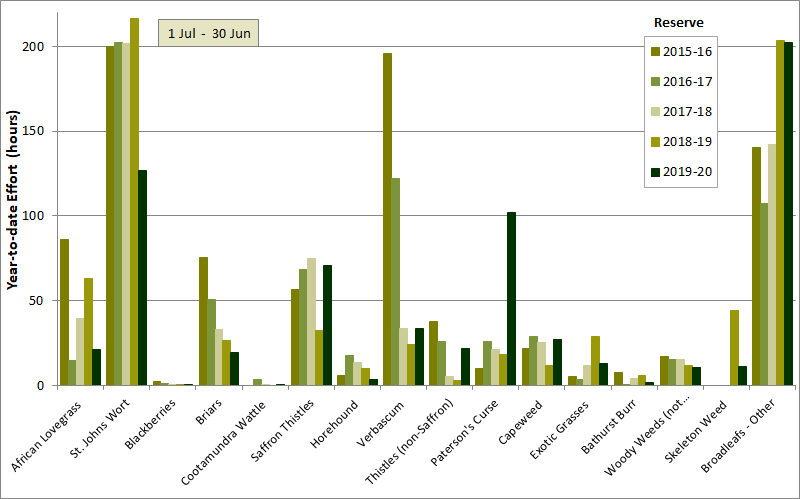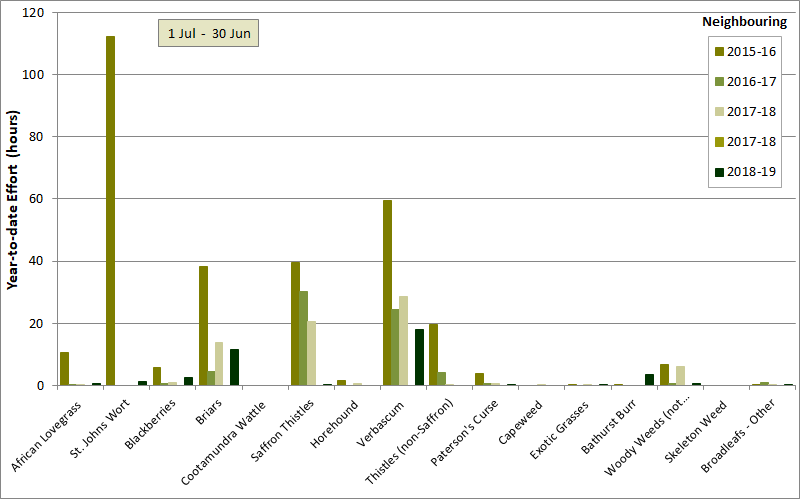| Weed type
| Comparative
Effort
(relative to last season; Reserve only)
| Likely reasons
|
| African Lovegrass
| much less
| This is attributed to reduced grass activity in the hot, dry conditions although since early March it has been flourishing again outside the Reserve but not so much inside. |
| St. Johns Wort |
much less
|
The amount of St. John's Wort was much less in spring than last season because of the hot, dry conditions. Although the wet late summer stimulated more growth than normal, spraying it took less time than normal.
|
| Blackberries |
similar |
Treatment is only partially completed so far this season. |
| Briars |
less |
There have been less briars to deal with so far this season. Also, there was not time available for a second sweep in Bottom Pinnacle. |
| Cootamundra wattle |
similar |
There are not many on the Reserve and treatment is occasional. |
| Saffron thistles |
much more |
The dry winter and continued hot, dry conditions reduced their emergence and growth in spring. The late summer rain has stimulated a resurgence that result in increased effort in May/June. |
| Horehound |
much less |
Horehound is decreasing in prevalence across the Reserve in response to treatment in previous seasons; treatment is sporadic. |
| Verbascum |
similar |
There was very little Verbascum in spring, which was also the case last season. It is hoped that this reflects successful control rather than seasonal weather conditions. There was increased prevalence as a result of the late summer rainfall but so far has been in isolated pockets able to be targeted fro past experience resulting in moderate effort required.
|
| non-Saffron thistles |
similar much more |
These have been largely under control on the Reserve but the late summer rain caused their resurgence, although still in smaller numbers than a few years ago. |
| Paterson's Curse |
much more |
Paterson's Curse seemed to be better suited to the dry conditions this season that many other weeds and grew prolifically following the late summer rainfall. It has required more effort than any other season except 2013-14. |
| Capeweed |
much more |
Effort was much more than last season but similar to previous seasons; unfortunately it was not sufficient for adequate control. |
| Exotic grasses (Serrated tussock, Chilean Needle grass and other exotics) |
much less |
The dry season seems to have reduced the prevalence of the target species in this grouping. They do not seem to have been as competitive following the summer rain as other species. |
| Bathurst Burr |
much less |
Bathurst Burr responded well to the summer rain and occurred in laces we haven't found it before, but we caught it while small so that it has resulted in less effort. |
| Other woody weeds |
less |
There are very few woody weeds left in the Reserve and neighbouring paddocks. Treatment is sporadic. |
| Skeleton weed |
much less |
Skeleton weed treatment has only been monitored since last season when a concerted effort was spent on it. It has received less attention this season so far. |
| Miscellaneous broadleaf weeds |
similar |
This category includes Hoary mustard, Prickly lettuce, fleabane, flatweed, catsear, Tragopogon, plantain, etc. The amount of effort spent on these depends more on the resources available than the prevalence of the weeds. Grubbing teams this season have had few other targets. |




